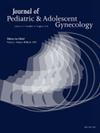39. Extended Use of the Etonogestrel Implant in AYA
IF 1.7
4区 医学
Q3 OBSTETRICS & GYNECOLOGY
引用次数: 0
Abstract
Background
Although the etonogestrel implant is FDA approved for 3 years, recent data demonstrate efficacy up to 5 years. Evidence supporting extended use is limited in adolescents and young adults (AYA), especially those with higher BMI. We report on the AYA experience of extended implant use.
Methods
This secondary data analysis used prospectively collected QI data of all implant insertions with ≥1 follow-up visit from September 2012 to December 2023 across 4 U.S. adolescent medicine practices. Baseline demographic and clinical characteristics were assessed. We used Chi-Square and Fisher's Exact tests to compare clinical characteristics between participants with device removal before 3 y, 3-4 y, and >4 y. Univariable logistic regression was utilized to assess for factors associated with extended use. Kaplan Meier curves estimated continuation rates and Cox proportional-hazards modeling examined the risk of implant discontinuation accounting for site using a robust sandwich estimator
Results
We included 1317 AYA (mean age 18.6 y (SD 2.5)) in our analysis. Patients primarily identified as Hispanic/Latinx (36.4%), Black/African American (21.3%), or White (21.1%). Based on age-appropriate classifications, most participants were normal weighted (44%) at time of insertion; 15.4% were overweight, 27.9% obese. Of the 807 implant removals, unsatisfactory bleeding (45.4%) and weight concerns (11.9%) were the most frequent reasons for removal. One-fifth (20%) of removals (n=200) occurred 3-4 y after insertion, and 8% (n=67) >4 y. Factors reported at removal that were significantly associated with shorter use of implant (≤3 y vs >3 y) included perceived unsatisfactory uterine bleeding (OR 3.94, 95% CI 2.77 - 5.59, p<.05), weight concerns (OR 14.17, 95% CI 4.44 - 45.21 p< .05), and mental health change (OR 3.94, 95% CI 1.78 – 8.73 p<.05). There were no pregnancies noted with extended implant use. The 1-year continuation rate was 78%, dropping to 56%, 36%, 12% and 2% at years 2, 3, 4, and 5. Our survival analysis (Fig) demonstrated a significant difference between BMI categories and time to discontinuation. Obese patients had the lowest discontinuation rates for the study period compared to normal weighted patients (hazard ratio adjusted for site 0.945, 95% CI 0.921-0.970, P<.0001)
Conclusions
Over a quarter of participants kept their implant >3 years. AYA are more likely to undergo early device removal for concerns related to mental health change, unsatisfactory bleeding, and weight. AYA with obesity at time of insertion may keep their device longer. No pregnancies were observed. Clinicians should engage in shared decision making with patients regarding extended use of the implant.
39. 依替诺孕酮植入物在AYA中的扩展应用
虽然etonogestrel植入物被FDA批准为3年,但最近的数据显示其疗效长达5年。支持在青少年和青壮年(AYA)中延长使用的证据有限,特别是那些BMI较高的人。我们报告AYA延长种植体使用的经验。方法采用前瞻性数据分析,收集2012年9月至2023年12月4个美国青少年医学实践中随访≥1次的所有种植体插入的QI数据。评估基线人口统计学和临床特征。我们使用卡方检验和Fisher精确检验来比较在3岁、3-4岁和4岁之前取出器械的参与者的临床特征。单变量逻辑回归用于评估与延长使用相关的因素。Kaplan Meier曲线估计了延续率,Cox比例风险模型使用稳健的三明治估计法检查了考虑部位的种植体终止风险。结果我们在分析中纳入了1317例AYA(平均年龄18.6岁(SD 2.5))。患者主要为西班牙裔/拉丁裔(36.4%)、黑人/非裔美国人(21.3%)或白人(21.1%)。根据年龄分类,大多数参与者在插入时是正常加权的(44%);15.4%的人超重,27.9%的人肥胖。在807例种植体移除手术中,不满意出血(45.4%)和体重问题(11.9%)是最常见的移除原因。五分之一(20%)的移除手术(n=200)发生在植入后3-4年,8% (n=67)发生在植入后4年。报道的移除手术与较短的植入使用时间(≤3年vs = 3年)显著相关的因素包括感觉子宫出血不满意(OR 3.94, 95% CI 2.77 - 5.59, p< 0.05),体重问题(OR 14.17, 95% CI 4.44 - 45.21 p<;.05)和心理健康变化(OR 3.94, 95% CI 1.78 - 8.73; 0.05)。长时间使用植入物未发现妊娠。1年延续率为78%,在第2、3、4和5年分别降至56%、36%、12%和2%。我们的生存分析(图)显示BMI类别和停药时间之间存在显著差异。与正常加权患者相比,肥胖患者在研究期间的停药率最低(校正部位风险比0.945,95% CI 0.921-0.970, P< 0.0001)。结论超过四分之一的参与者将种植体保留3年。由于担心心理健康变化、出血不满意和体重,AYA患者更有可能接受早期器械移除。在植入时肥胖的人可能会保留更长时间。没有观察到怀孕。临床医生应与患者共同决定是否延长植入物的使用。
本文章由计算机程序翻译,如有差异,请以英文原文为准。
求助全文
约1分钟内获得全文
求助全文
来源期刊
CiteScore
3.90
自引率
11.10%
发文量
251
审稿时长
57 days
期刊介绍:
Journal of Pediatric and Adolescent Gynecology includes all aspects of clinical and basic science research in pediatric and adolescent gynecology. The Journal draws on expertise from a variety of disciplines including pediatrics, obstetrics and gynecology, reproduction and gynecology, reproductive and pediatric endocrinology, genetics, and molecular biology.
The Journal of Pediatric and Adolescent Gynecology features original studies, review articles, book and literature reviews, letters to the editor, and communications in brief. It is an essential resource for the libraries of OB/GYN specialists, as well as pediatricians and primary care physicians.

 求助内容:
求助内容: 应助结果提醒方式:
应助结果提醒方式:


